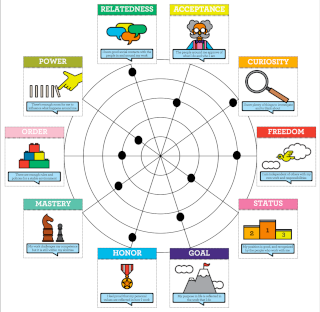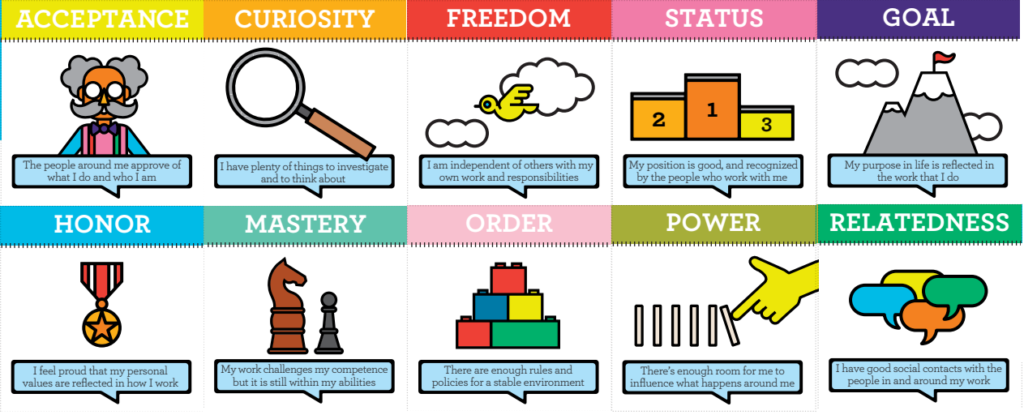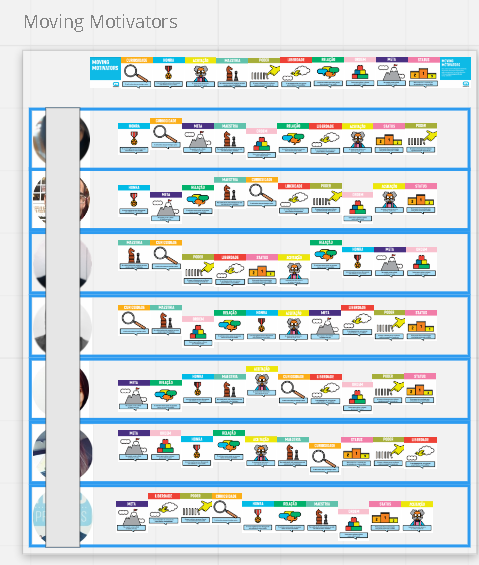Moving Motivators

https://management30.com/practice/moving-motivators/
Introduction
There are questions that are difficult to answer.
Who are you?
How do you see yourself in 5 years?
Why are manhole covers round (by Google)?
How much would you charge to wash all your Seattle windows(by Facebook)?
I know that answering this question is challenging, after all what should I consider to answer this question?
Passion?
Money?
Challenge?
But if in addition to this question I still asked you:
What moves your team?
Take a deep breath and let’s go.
Seeking to better understand our internal strength, here at Rede/Itau, in the software development sector, we are looking for methods that we can understand better.
We found in Management 3.0 a very good tool to apply to teams: the Moving Motivators game.
This game brings a personal reflection as a team, where each one can express to the other members what drives them forward and makes them come to work every day.
The game was created by Jurgen Appelo and brings in its cards 10 personal motivations that can give a direction to answer the question in this post.
Are they:
Curiosity: I have plenty of things to investigate and to think about.
Honor: I feel proud that my personal values are reflected in how I work.
Acceptance: The people around me approve of what I do and who I am.
Mastery: My work challenges my competence but it is still within my abilities.
Power: There’s enough room for me to influence what happens around me.
Freedom: I am independent of others with my work and my responsibilities.
Relatedness: I have good social contacts with the people in my work.
Order: There are enough rules and policies for a stable environment.
Goal: My purpose in life is reflected in the work that I do.
Status: My position is good, and recognized by the people who work with me.
Each card brings a description of each motivation, to better apply with your team and can be better understood through this link.
Explain the Practice
Moving Motivators consists of 10 cards with different motivators, as shown in the image below.

I gave a brief presentation on the 10 Motivators of Moving Motivators.
Each member individually arranged the cards according to their preferences, from the highest motivator to the lowest, in order according to their priority from left to right.

Afterwards, each member explained their sequence to the others, generating a great debate and lots of interaction.
It was a very pleasant time, with a lot of conversation, without haste, and each one could freely expose their impressions.
A final step that I asked everyone was to assess the current context of their actions in the team, checking whether their motivators are being met (cards up) or not (cards down).
We then had a very productive discussion about this analysis.
I suggest doing some provocation at this point to generate more details and also take the opportunity to take notes on what you think is important;
As we are all working on a Home Office basis, I used the Miro tool for the visual and collaborative experience.
I was careful to put their image on their decks, and I also decided to participate in the exercise, so they could also get to know me better.
Why did you decide to use this practice
Motivating the team and giving feedback to employees were the decision points to apply this dynamic.
Our team need oxygenation and incentive for a new project that was to come.
We decided with the team to understand the motivators that made the wheel spin.
With the data obtained in the dynamics, it is possible to animate the team and make the future challenge not so great.
The feedback from the guys was really cool, they loved the activity, and I felt that there was a much greater sense of unity among the team.
Everyone was able to get to know each other a little more and strengthen ties, and we were able to validate some of the team’s structures and their functioning.
Understanding what motivates collaborators gave us the way to know how to act.
These motivators give the necessary freedom and encouragement to each team employee.
How did you use this practice
After explaining to the team that the goal of the dynamic will be to get to know us better individually and collectively, we invite members to individually reflect on which motivators are most important to them.
We put the board (miro) and present and explain the motivators one by one, asking them to put from left to right and top to bottom the motivators that are most important to them.
From left to right in level of importance.
From top to bottom if they are attended. (up attended/ down not attended).
In online action, we open questions to provoke good debates.
From then on, we requested the points that generated an impediment and made the values go down (not met)
The team defined the necessary points for the motivators that were not being met.
And the leaders committed to supporting employees in achieving the motivators.
Quarterly we repeat this dynamic seeking to equalize the team’s motivation.

Your learnings as facilitator
With dinamica we can have many gains, whether for the team’s self-knowledge and knowledge, it also serves to create harmony and trust with the team, as people talk more about themselves, opening up more.
At the end of the application, we decided to tabulate — in, spreadsheet — the data of all participants.

This helps the manager to be able to verify the motivation points of his team and try to achieve faster happiness and efficiency of his team.
Another benefit that we see is that the manager can be applied when hiring candidates, analyzing in which team they would have more motivational affinities, or even in which team this candidate would be complementary, adding a new motivation to the team.
Each employee is unique, understanding what motivates each individual and being able to monitor it can help you get the most out of each one. And when you manage to do this without negatively affecting everyone but positively things go well.
Achieving productivity and, at the same time, harmonically engaging everyone with your company’s goals is always positive.
The coolest thing is that despite this being a common practice in the company, the area I work in is relatively new and not everyone uses or knows this tool. But as the repercussion has been very positive, the General Manager of the area has already asked me to share the experience with the other Agile Masters in our operational review. And this agenda has already been included in the next meeting next week.
The cool thing is that it will be a great opportunity to talk about the dynamics, understand the different scenarios that others are situated in, and analyze adaptations that we can make in each context, creating something in the spirit of the tool, but customized for the specific context of each area. I can’t wait anymore.
Now it’s time to run the exercise with the more teams, capture the lessons learned, and think about when we should start a new cycle, with a new round of Moving Motivators.
After all, what moves you?
